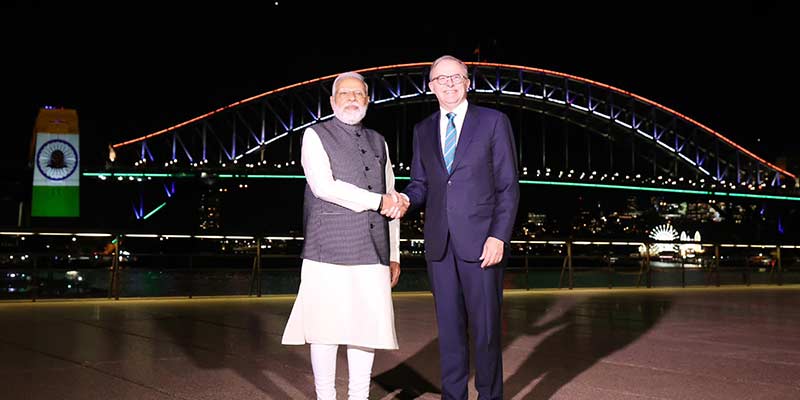- India
- May 25
India, Australia aim to finalise CECA this year
• India and Australia inked a migration and mobility partnership pact and resolved to conclude a comprehensive trade deal by the end of year to significantly expand economic ties.
• The Migration and Mobility Partnership Arrangement (MMPA) will further facilitate mobility of students, professionals, researchers, academics and others, including through a new skilled pathway named MATES (Mobility Arrangement for Talented Early Professionals Scheme) specifically created for India.
• The pact was signed after wide-ranging talks between Prime Minister Narendra Modi and his Australian counterpart Anthony Albanese.
• Albanese said the aim is to conclude the Comprehensive Economic Cooperation Agreement (CECA) by the end of the year.
• On December 29, 2022, India and Australia implemented the Economic Cooperation Trade Agreement (ECTA) and are now negotiating to expand its scope for CECA.
• CECA will create new employment opportunities, raise living standards and improve the general welfare in both countries.
• The Prime Ministers welcomed progress towards establishing an Australia-India Green Hydrogen Taskforce.
• The new Centre for Australia-India Relations will be headquartered in Parramatta. The Centre began operations this month and will drive deeper engagement with India through business, policy and cultural activities and work with Indian diaspora communities.
• PM Albanese also announced the establishment of the new Australian Consulate-General in Bengaluru.
India-Australia relations
• India and Australia established diplomatic relations in the pre-Independence period, with the establishment of India Trade Office in Sydney in 1941.
• The end of the Cold War and simultaneously India’s decision to launch major economic reforms in 1991 provided the first positive move towards development of closer ties between the two nations.
• Both countries upgraded bilateral relationship from ‘Strategic Partnership’ in 2009 to Comprehensive Strategic Partnership (CSP) in 2020.
• India and Australia are partners in the trilateral Supply Chain Resilience Initiative (SCRI) arrangement along with Japan which seeks to enhance the resilience of supply chains in the Indo-Pacific Region.
• Further, India and Australia are also members of the Quad, also comprising the US, and Japan, to further enhance cooperation and develop partnership across several issues of common concern.
• India is the ninth largest trading partner of Australia. During 2021, bilateral trade in goods and services was $27.5 billion, with exports of goods and services worth $10.5 billion and imports of goods and services worth $17 billion.
• India’s merchandise exports to Australia grew 135 per cent between 2019 and 2021. India’s main exports to Australia are refined petroleum, medicaments, pearls & gems, jewellery, textile articles. India's major imports are coal, confidential items of trade, copper ores & concentrates, natural gas, non-ferrous waste & scrap, ferrous waste & scrap and education related services.
• Australia has traditionally been a major trading partner for the Indian garment industry with exports occupying a share of about 4 per cent of total Australian garment imports.
India, Australia CECA negotiations
• India and Australia launched negotiations for a Comprehensive Economic Cooperation Agreement in May 2011. There were many rounds of negotiations before both countries decided to suspend negotiations in September 2015, pending the outcome of other multilateral regional negotiations.
• In June 2020, as part of the Joint Statement on a Comprehensive Strategic Partnership between India and Australia, Prime Ministers Narendra Modi and Scott Morrison decided to re-engage on a bilateral CECA while suitably considering earlier bilateral discussions, where a mutually agreed way forward can be found.
• In 2021, at the 17th India-Australia Joint Ministerial Commission meeting on September 30, ministers Piyush Goyal and Dan Tehan formally re-launched CECA negotiations and reaffirmed their commitment to liberalise and deepen bilateral trade in goods and services.
• Recent years have seen remarkable growth in the trading relationship between India and Australia, fuelled by the many complementarities between the two economies.
• India mainly exports refined petroleum, medicaments, railway vehicles including hovertrains, pearls and gems, jewellery, and made-up textile articles. While imports include coal, copper ores and concentrates, gold, vegetables, wool, fruits and nuts, lentils, and education-related services.
• Modi and Albanese also witnessed the signing of the terms of reference of the Australia-India Green Hydrogen Taskforce which will explore opportunities in the area of renewable hydrogen.
Manorama Yearbook app is now available on Google Play Store and iOS App Store

